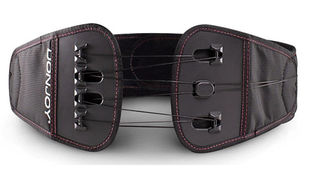Neck & Back
Lower Back Pain: A discussion of spinal/back supports.
According to the World health organisation (WHO) more than 600 million people a year suffer from lower back pain (LBP), with that number increasing to more than 800 Million by the year 2050. (https://www.who.int/news-room/fact-sheets/detail/low-back-pain)
The WHO also states that LBP is the single leading cause of disability worldwide and can be experienced by persons of any age, albeit, mostly affecting persons between the ages of 50 and 55.
Various other conditions are associated with LBP, namely sharp electrical shocks and numbness/weakness in the leg, which may or may not involve the compression or injury of the spinal nerve root.
According to the WHO, 90% of LBP issues can be defined as non-specific, with risk factors such as low physical activity, smoking or high physical stresses being the main contributors.
Treatment and management plans for LBP from the WHO include, Physical therapies, psychological/social support, reducing strain at work, and various lifestyle changes.
While the WHO’s treatment recommendations are acknowledged, there are many good peer reviewed research findings, showing that wearing a lower back support, not only reduces back pain but has a positive influence on the wearer’s quality of life.
Below are a few research articles that I’d like to bring to your attention, discussing the positive effects of external spinal supports and braces.
“
1. The Role of Spinal Orthoses in Osteoporotic Vertebral Fractures of the Elderly Population (Age 60 Years or Older): Systematic Review
Conclusion: “The use of spinal orthoses in neurologically intact elderly patients aged 60 years and older with osteoporotic compression vertebral fractures results in improved biomechanical vertebral stability, reduced kyphotic deformity, enhanced postural stability, greater muscular strength and superior functional outcomes.”
2. The impact of continuous use of lumbosacral orthoses on trunk motor performance: a systematic review with meta-analysis.
Conclusion: The meta-analyses demonstrated no negative effect by the continuous use of an LSO for 1–6 months.
3. Effects of External Abdominal Pressure Support on Dynamic Balance: A Randomized Crossover Study.
Discussion points:
* Lumbar belts and braces support spinal stability by tightening the abdominal wall and increasing the Intra-Abdominal Pressure (IAP), which reduces the load on the spine.
* A 4 kPa increase in the IAP results in a 25% improvement in spinal stability.
* Results suggest that external Abdominal pressure support (APS) may be an effective way to support dynamic balance during forward bending movements such as picking up objects and lifting
4. Effectiveness of lumbar orthoses in low back pain: Review of the literature and our results.
* The authors of this review are of the opinion that the implementation of trunk orthoses is void of side effects and beneficial to patients. Treatment regimens that include the prescription of lumbar orthoses result in significant improvements in functional capacity, pain reduction and patient compliance.
5. Spine Bracing: When to Utilize—A Narrative Review
* Hyperkyphosis - A 2020 systematic review by Kweh et al. demonstrated that bracing in the elderly patient with kyphosis and compression fractures resulted in improved biomechanical vertebral stability, reduced kyphotic deformity, enhanced postural stability, greater muscular strength, and superior functional outcomes
* Spinal Bracing for Chronic Lower Back Pain- Samani et al. found that while pain levels improved in all groups, the greatest improvement in pain levels and proprioception was recorded by the group who wore the tightest and highest-pressure braces.
* Post Operative support- Spinal braces should be avoided post-operatively as they restrict natural motion and are often considered redundant as orthopaedic hardware stabilizes the spine appropriately, except for patients at risk for weakened stabilization or fusion, such as smokers or diabetics.


























